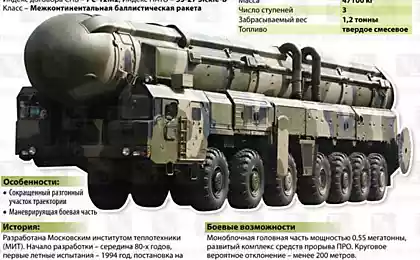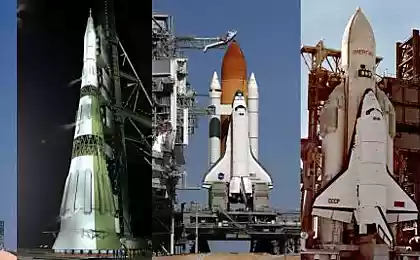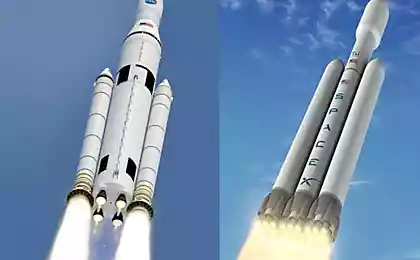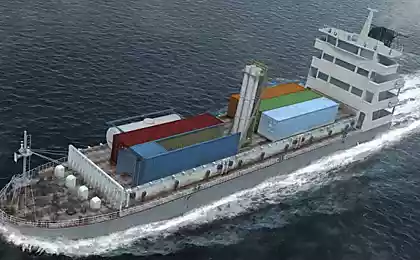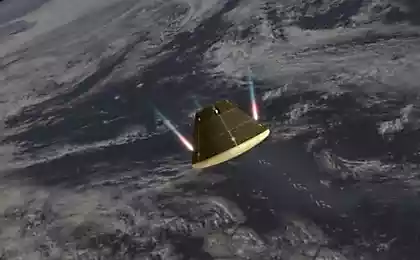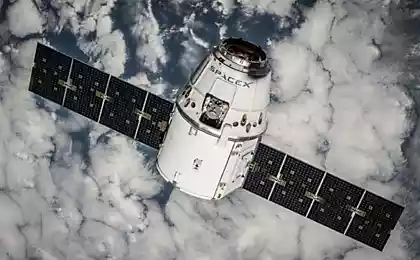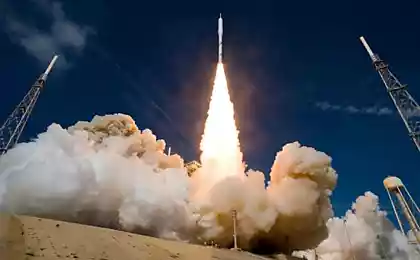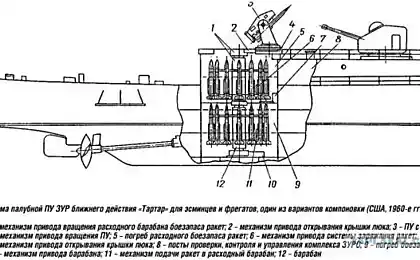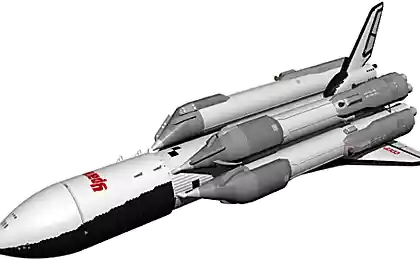Chronicle sverhtyazhelovesov space. Part 2. "Park" reusable period
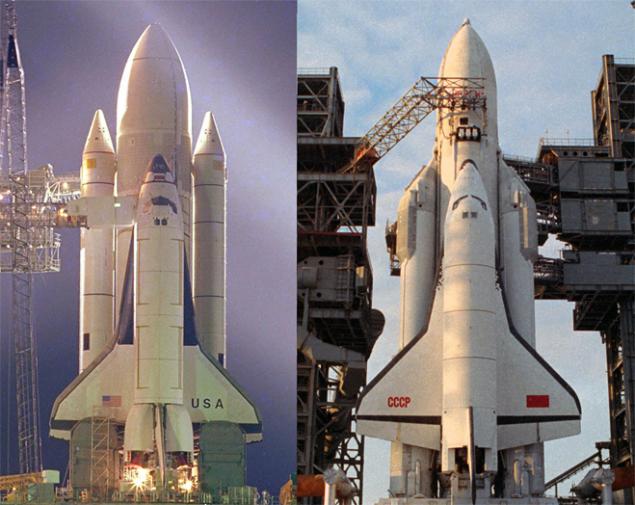
In 1971, the year before the last lunar expedition ship "Apollo", the company Rockwell, on behalf of NASA, began developing new space systems reusable. The program is called the «Space Shuttle» (Space Shuttle) was presented to the US government as a commercial and had to use studies for previous, purely "ideological" Apollo program.
At the same time, at the other end of the Earth, Soviet specialists have noted that significant benefits system «Space Shuttle» over disposable has not. However, the project considered viable as an addition to the existing transport system.
Against the background of the general uncertainty about the purpose of the American project, it was decided to develop a reusable ship to provide military parity with the United States.
By adopting the draft 1972goda system «Space Shuttle» consisted of three main parts:
1. Two side solid rocket boosters of Thiokol, played the role of the first stage, accounting for 60% of the total weight of the space system (and giving 80% of the start page of thrust).
Each unit TRU (SRB) weighed on the 580t and at the starting thrust into 1200T (u.impuls 242c), burned 500 tons of ammonium perchlorate (oxidizer), aluminum (fuel) and iron oxide (catalyst) in an amount up to the height of "shooting" at 45km . After that, each of the blocks in height and 50m in diameter 3, 7m, made smooth splashdown in the ocean with the help of parachutes. In practice, allowed the use of multiple units 10 TRU.
Shooting GWS side blocks (SRB) and their splashdown i>

2. Next, took over the baton to three liquid rocket engine (LRE), a main component of reusable system - Orbiter (or hook). This common project of Rocketdyne, Rockwell and Boeing weighing about 80 tons (without payload), 37m in length and wingspan of 24m, is a history of the first reusable spacecraft. Orbiter could have a crew of up to 7 people, and in the cargo compartment dimensions 18m / 4, 6m output to 25t into low Earth orbit (or return to earth 14t).
Technology curiosity associated with the shuttle cargo bay The original dimensions of the cargo hold NASA were imposed by the Ministry of Defense under the expectation dimensions of promising optical reconnaissance satellite in real time - серии«KH 11 » (Keyhole -« Keyhole "). Optics of these satellites is considered a "parent" in relation to the famous space telescope "Hubble».
Soviet specialists who learned about KH 11 only in the late 70s, very concerned about the similarity of the shuttle's cargo bay and dimensions of Soviet space stations "Diamond" and "Salute". It had a great influence on the choice of the dimensions of the cargo compartment "Buran". By the way the US military realized that NASA "a little" exaggerated the commercial benefit of shuttles (together with the stated frequency of starts 20 / year), launched their satellites predominantly via RN series "Titan". The only known case of removal shuttles (Atlantis, STS 36) satellite - Scout Series KH 11 took place on February 28, 1990.
With three main propulsion engine hydrogen RS 25, the total thrust of 540t, a resource to 1200C and u.impulsom 363s (450C in a vacuum), Orbiter burns in Big within 8, 5 minutes (6, 5, after the separation of TRU) 700t of fuel from an external fuel Buck (the third element of the system with dimensions of 47/8, 4m) to the height of its branches - 105 km. Next Orbiter went into the desired orbit using its own energy orbital maneuvering fuel system (OMS), in order to avoid elimination of TB shuttle into orbit.
The total thrust of the engines of the system at startup - 2900t, the mass of the system itself - 2030t.
RS 25 engine installation on Orbiter i>

The scheme reusable system i>
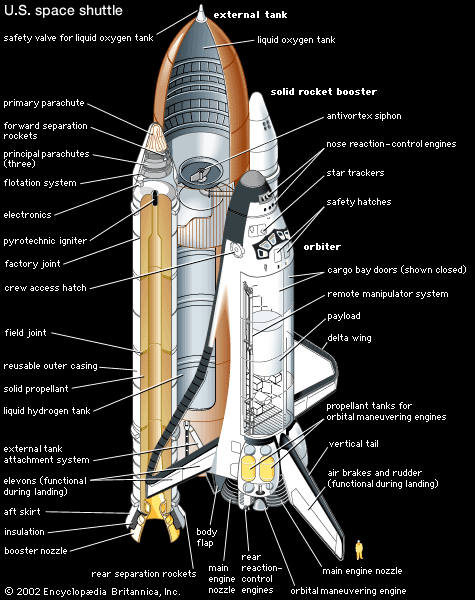
The first flight of the space system «Space Shuttle», April 12, 1981. Tragically famous shuttle Columbia i>
One of the first projects of the Soviet reusable spacecraft - MTC-VP , could be used together with the still "run in" N-1 rocket (left) or with block rocket Glushko after project closure H 1 in the middle of the 70th (right).
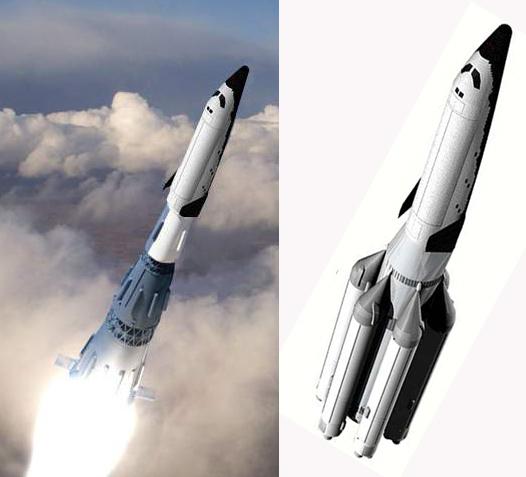
However, because no large (compared to the weight of the ship), the area of resistance to air flow during reentry, thermoguards had to "suffer" too high a temperature. General Designer of Soviet shuttles GE Lozino-Lozinski call this system "polumnogorazovoy" due to too high volume mezhpoletnyh works.
Parallel to this, it was decided to 75godu go the shortest way and fully replicate the US system, which took shape in the OS 120 project .
However, due to the fact that the Soviet project was mainly for military purposes, the OS 120 has two big drawbacks:
1. Testing of this technology was too time-consuming for the Soviet space program, and required additional time lag is significant for the military was unacceptable.
2. The orbiter was the only large-sized "passengers" for a super-heavy and technology-intensive systems. Remaking it in a separate RN in the future require additional time and money.
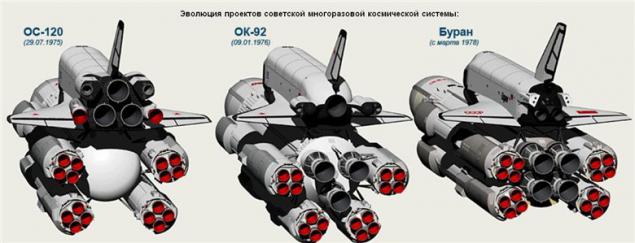
Starting with the project OK 92 in the 76th, and before the adoption of the final scheme reusable system in '78 ( with the shuttle "Buran» development NGOs "Lightning"), 4 side of the first stage of the accelerator (Block A) "pereobulsya" of RD 123 with a thrust of 600 tons, 4 uprated RD 170, weighing in at 9, 7t, every thrust of 740t and fantastic (for kerosene LRE) y. pulse 310c. at sea level! All four blocks of dimensions 38 / 4m 140c had to work, during which "burns" kerosene / oxygen fuel total weight 1230t to 53km altitude, giving a second stage with the load acceleration of 1, 8km / s. Although each RD 170 was certified for 10-fold use, all 4 units, as well as all "Energia", were disposable.
the first stage unit "Energia» i>
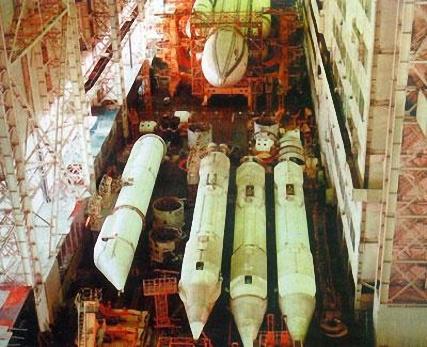
Multi-chamber RD 171 (left version of RD 170 for "Zenit") and RD 108 (right, second stage of "Union"), bear a peculiar technical "signature" of native 476 KB / NGO "Energomash" which led in n. Glushko i>
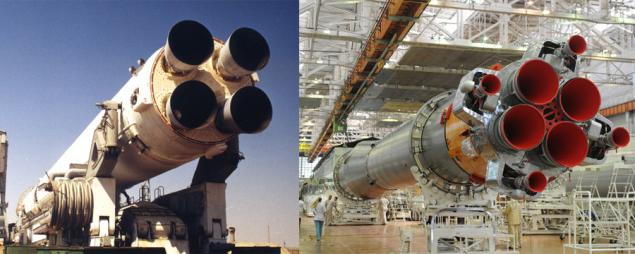
Three hydrogen rocket engine 11D122 (Rod 200-250t) as well have been replaced by 4 RD 0120 with traction in 155-200t and u.impulsom 353-455s (sea level-vacuum) developing Voronezh KBKhA. Rearrange them in the tail of the ship under the fuel tank, though, and put an end to repeated use, but greatly simplified the production of engines and improve the aerodynamics of the vehicle. But most importantly, it is possible to create a completely new and universal RN superheavy "Energy».
Soviet hydrogen LRE 0120 i>
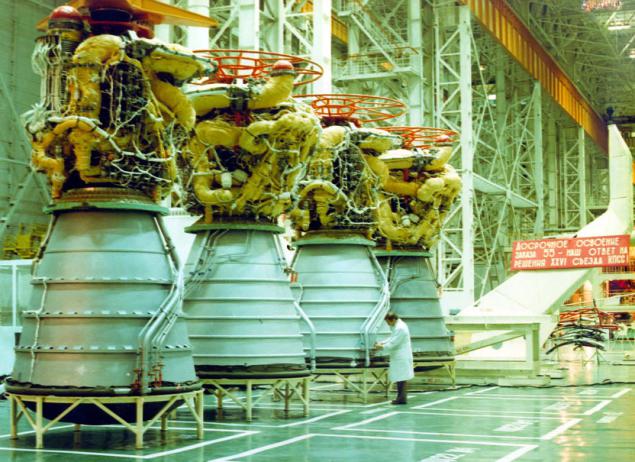
Thereby obtaining a second stage unit "C" had a height of 57m in diameter at 7, 7m and retained the same amount of fuel TB Space Shuttle - 700t oxygen and hydrogen. The stage is separated on 480sekunde flight, reaching a height of 115km. Further removal of the goods provided by its own engines, the orbiter or the third stage with the payload.

"Energia" is a part of the universal cosmic system. Thus, choosing a certain number of blocks of the first stage and changing the volume of the second stage tanks could achieve the desired load capacity in a relatively short time.
The total weight of "Energia" was 2400t, the total thrust of the engines at the start - a record 3550t! The first flight of the rocket made 15 May 1987 year from Baikonur with oversized mock satellite "Polyus»
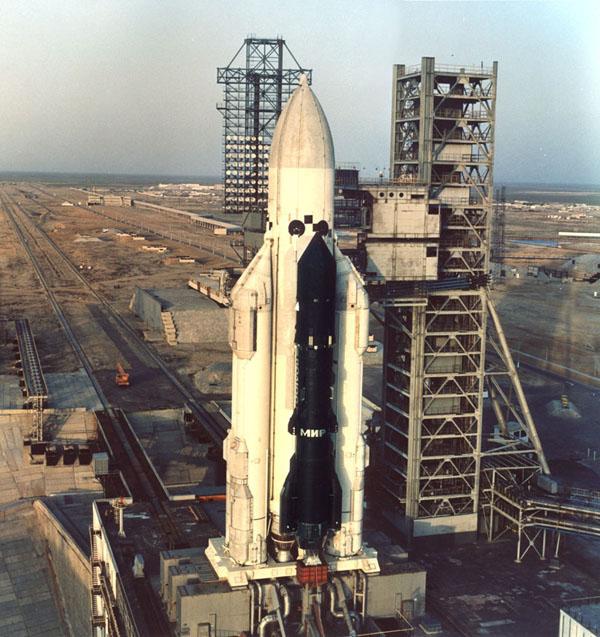
Basic version allows to use one of the blocks as the first stage "Zenit» (still in use) with lifting capacity of 15 tons on the supporting low orbit. A selection of two units allows you to display already 30t payload ( "Energia M» ).
A full-scale mock-up "Energia M" at Baikonur i>

A selection of 8 reinforced first stage unit with uprated RD 170 (up to more than 800 MT of thrust each!) And the second stage of the "Energy of M" as the third stage, allows project Rocket - giant" Volcano » weighing 3800t placing into Earth orbit already 170t!
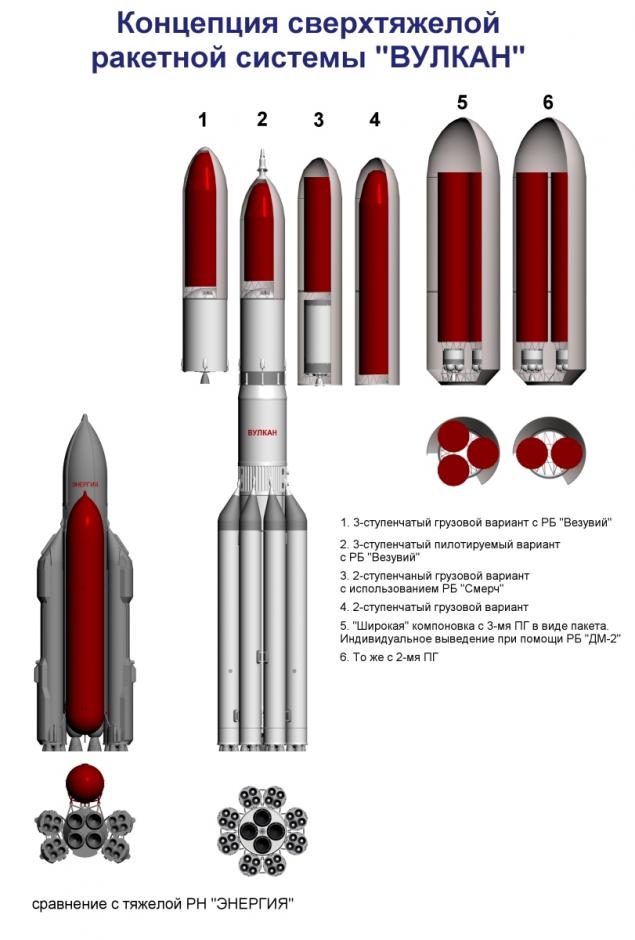
Himself Soviet orbital shuttle despite a radical alteration of the base OS 120 project, in general retained its overall weight and dimensions parameters American "brothers" - 80t, at a length of 35m, 24m in wingspan and size of the cargo bay 18m / 4, 6. The weight of the payload - 30t, Return shipping weight - 14t.

Details of the flight of the "Energy-Buran» i>
Well characterized transformation project in the OS 120 "Energy-Buran", one of its designers GE Lozino-Lozinski :
«Copying, (...), it is certainly quite deliberate and grounded during those engineering development that took place in the course of which it was made, as already mentioned above, many changes in the configuration and design. The main political requirement was to ensure the payload bay dimensions, with the same payload bay "Space Shuttle". » Blockquote> Just on the American Space Shuttle program was built 5 Orbiter: Columbia, Challenger, Discovery, Atlantis and Endeavour. The first flight of the program was made on April 12 1981. (Shuttle Columbia). Last Atlantis flight made 8 July 2011.. Total space shuttles delivered to 1300t cargo and about 70% of all former astronauts in space.
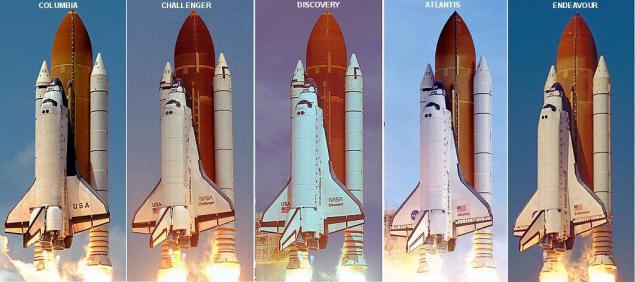
The first and last flight of the Soviet shuttle Buran, November 15 1988goda which had seemed to confirm the general trend of world space to a reusable system, has already managed to thunder the first harbinger of the sunset era reusable.
January 28, 1986, at 73 seconds of flight, due to problems with one of the side accelerators TRU exploded shuttle Challenger . Death of 7 crew members made it the worst accident in the history of space Space (before the crash Colombia in 2003).
Ice "souls" reusable space exploration. The tragic flight of the shuttle Challenger i>
Shuttles have flown for 22 years (from 89 to 2011), and even the shuttle Endeavour was built to replace Challenger. The program "Energy-Buran" was finally closed in 1993, amid economic chaos in Russia.
However, in the late '80s began to take shape the contours of the future world space, more precisely, our present to you. About promising Russian, Chinese and American RN superheavy class and will be discussed in the final section of this review.
Moon Part 1 "dinosaurs».
Source: habrahabr.ru/post/225895/



